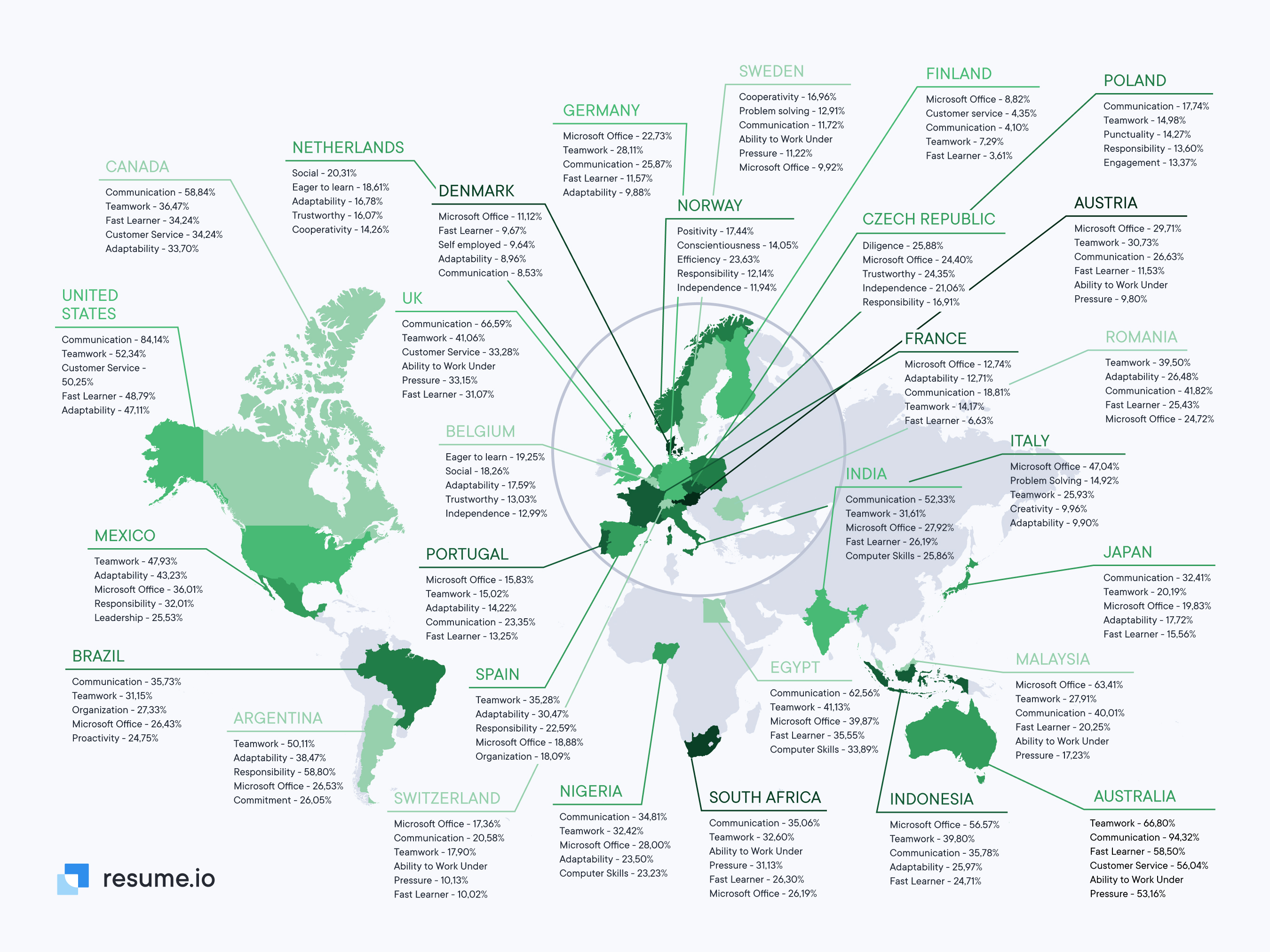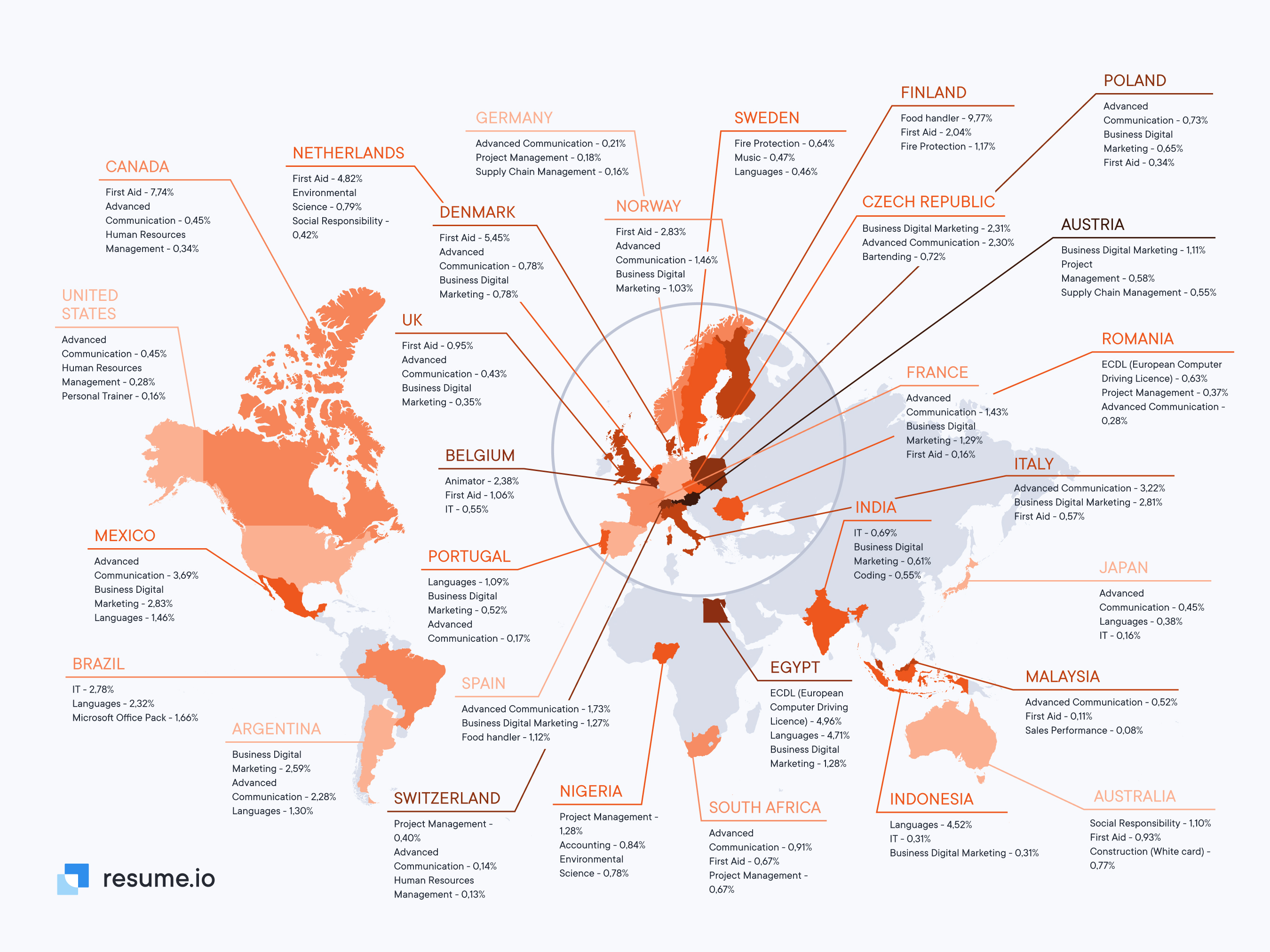Do you want your skills section to sound like everyone else’s? On the other hand, do you want to leave out a top skill because many other resumes list it, too? Finding the balance between standing out and including all the skills employers seek can be a challenge.
An excellent resume skills section takes into account the attributes each employer seeks. But it also balances your particular strengths with those that are bottomline requirements for the position. The more information you have, the more likely you are to curate a resume skills section that both gets you past the Applicant Tracking System and entices a recruiter to offer you an interview.
In this blog you will find a Resume.io analysis completed in Q2 of 2023 of almost 7 million resumes from 30 countries around the world. Our report offers detailed data on exactly what skills and courses the competition is putting on their resume.
Top skills people around the world put on their resume
You won’t be surprised to know that employers in different countries (as well as different fields) value different skills, but the top five skills overall rank significantly higher than the rest. You know that within your work day you employ dozens more skills than you will include in your job application, but there are some that stand out as most important or desired.
In this era of collaboration, it’s no surprise that the No. 1 skill listed around the world is teamwork. In fact, 24% of applicants mention this ability. That’s followed closely by communication and Microsoft Office, both at 22%. Fast learner and adaptability round out the top 5 skills list at 18% and 16% respectively.
Notice that four out of those five are soft skills – highly sought after by hiring managers and more difficult to teach than hard skills such as how to use a spreadsheet. This data also reveals that the need for soft skills is common to most professions while hard skills target knowledge that is specific to a profession.
Top Desired Skills
If you’re wondering whether the skills listed on resumes mesh with the skills employers seek, here is LinkedIn’s top 10 most in-demand skills for 2023 and the percentage of resumes they are listed on within our analysis.
- Management
- Communication (22%)
- Customer service (5%)
- Leadership (1%)
- Sales
- Project management
- Research
- Analytical skills (Our data shows problem solving at 2%)
- Marketing
- Teamwork (24%)
Communication ranks high
While teamwork ranks highest worldwide, the skill that tops most individual country lists is communication. Can you think of a job that does not require the ability to listen and share information and ideas with others?
In several countries, more than half of all resumes mention this ability, some well above that percentage. In fact, in Australia, communication is everything with a whopping 94.3% of job applicants listing this ability on their resumes. The United States ranks second in this category, with 84.1%, followed by the UK with 66.5%; Egypt, 62.5%; Canada, 58.8%; and India, 52.3%.
Break it down
While listing communication on your resume may seem like an obvious choice, you can distinguish yourself by getting more specific.
Think about the four main categories of communication when you develop your skills section:
- Verbal
- Non-verbal
- Written
- Visual

Click here to see the image in full size
Top courses people around the world put on their resume
One method of demonstrating that you have the skills you claim is to offer evidence of coursework. If you guessed that many job hunters list some type of communication course on their resumes, you guessed right!
The most popular course listed on resumes worldwide is advanced communication, highlighted by 19% of applicants around the world. Second can be considered another type of communication: business digital marketing, which is named on 15% of resumes. Rounding out the top 5 courses are Languages at 8% and project management at 6%. Seventeen other courses received mention from at least 1% of worldwide job seekers.
The only other double-digit course is first aid, with 13%. The reason for the wider spread of course listings is that hard skills, or those specific skills necessary for your career, can be learned and it is much easier to develop and demonstrate this knowledge through coursework.

Click here to see the image in full size
Patterns in skills sections
Our analysis has revealed several patterns in skills sections. In most countries, fewer than 50% of resumes contain the same skills. In other words, applicants have named a wider variety of their attributes. However, in both Australia and the United States, the top 5 skills mentioned were listed by almost half of all job seekers. That means skills sections in those countries look quite similar to each other. You will also notice that all of those attributes are soft skills.
As already mentioned, the top skill in Australia is communication (94.3%). That’s followed by teamwork (66.8%), fast learner (58.5%), customer service (56%) and ability to work under pressure (53.2%).
Resumes in the United States mostly mimic that list, swapping out ability to work under pressure for adaptability (47.1%). The rest of the list: communication (84.1%), teamwork (52.3%), customer service (50.3%) and fast learner (48.8%).
In contrast, common skills on resumes in Finland garner less than 10% commonality, with the top skill being Microsoft Office proficiency with a mere 8.8% of people putting that on their resume.
Patterns in course listings
Course listings are spread much thinner than skills listings for the reasons discussed above.In many nations, most of the top 3 courses named appear on fewer than 1% of resumes. This may also be because not every job applicant includes classes they have taken.
One exception to this pattern is Egypt, where almost 5% of resumes include the European Computer Driving License (ECDL), a computer literacy program now known as International Computer Driving License (ICDL), and another 4.7% list language courses.
In Finland, a food handler course is popular, appearing on 9.8% of resumes, while in Denmark, 5.5% of applicants include a first aid course as do 2.8% of Norwegians. Mexico’s top 3 echo the international list of advanced communication (3.7%), business digital marketing (2.8%) and languages 1.5%).
Key takeaways
- Compiling a skills section and knowing which attributes to emphasis throughout your resume requires knowledge of what employers want.
- Use the data from Resume.io’s analysis of almost 7 million resumes worldwide to gain a competitive advantage.
- Instead of listing “communication” consider highlighting one of this umbrella category’s more specific skills.
- Employers in different countries are looking for different skills. This depends both on the industries in those nations and their culture.
View free resume samples for various industries and job types to get inspiration and boost your chances of landing your dream job.





